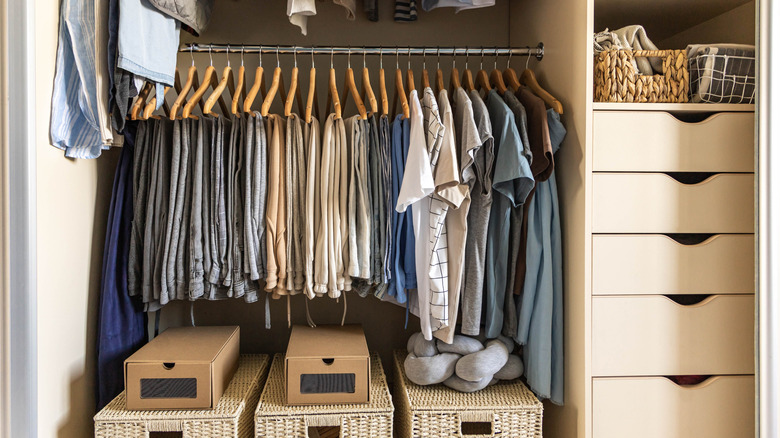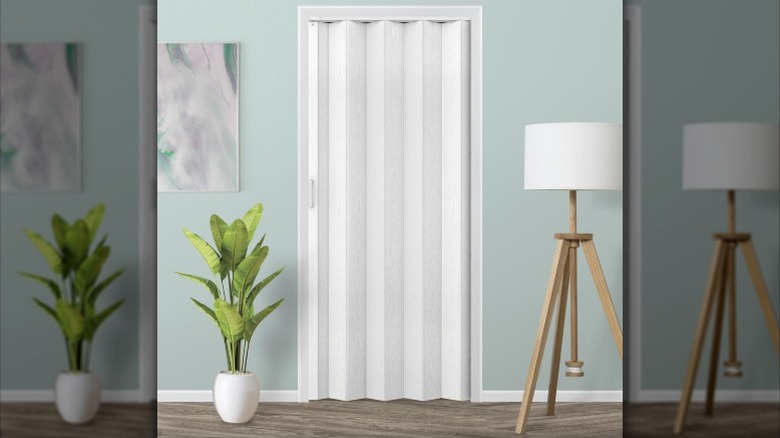The Closet Door Alternative That Saves Space And Looks Trendy
Looking for a chic alternative to bifold closet doors? While there are almost endless closet door options out there, few can compete with bifolds on their ability to condense the space you need for a door down to a few inches while still looking stylish. There is one closet door alternative, however, that's catching the eye of today's more adventurous design professionals tired of bifold's dominance in space-challenged homes. It boasts similar functionality, a mid-century aesthetic, and a cheaper (in many cases) price tag. Yup, we're talking about the accordion door — narrow panels of various materials fitted to a track and hinged together so they fold up when pressed or lay flat when pulled, just like their namesake musical instrument.
Once a fixture in American homes of the post-war period, it was, back then, considered a new technological advance in home design for its ability to save space; there was no need to include space to swing a door open in the building footprint. Favored by famed mid-century designers like Gio Ponti and Joe Colombo, these expandable doors were most commonly used to partition off rooms like, say, between the kitchen, dining room, and living room or hide away untidy areas of the home such as offices and (relevant to this article) closets. Today, they're more commonly seen in businesses and factories than homes, but with the footprint of the average American home shrinking, it's looking like this mid-century trend might become a 21st century reinvigoration — at least where closest are concerned.
Why should you choose an accordion door for your closet?
These origami-esque closet screens are undeniably space-saving; they're a go-to option for owners of tiny homes for good reason — think tiny home bedrooms that show you how to maximize space. Accordion doors dramatically reduce the need for the door-sized floor space that traditional swinging closet doors require. They also don't need a slot or wall space to slide into like pocket or barn doors. Some accordion doors collapse closed on both sides of a doorway, allowing you to reach into the corners of your closet with ease.
These doors are almost always made of lightweight materials, like fabric, faux leather, wood veneer, vinyl, and acrylic, and this ensures they're easy to push or pull across a closet opening for almost anyone — even children and less physically able older adults. Some brands and models are even ADA (Americans with Disabilities Act) compliant. These materials are, however, far more substantial than a mere curtain and because they're easy to install (and uninstall), they may even be suitable for renters.
Of course, accordion doors aren't without their detractors, who complain that these doors fall off their tracks, are noisy, and can make it hard to reach into closet corners if they only open one way. They often end up stuck in one position, with owners loathing having to drag them open and closed each time they want to access the closet. Some doors are flimsy and prone to breaking with age; spending more on a quality product and testing doors if you can is worthwhile.
Close up that closet: Where to buy and how to install an accordion door
Woodfold has been making accordion doors since 1957. Their Series 220 doors are designed for closets and made bespoke, so costs vary depending on your unique specifications. For off-the-shelf doors, shop at the big box retailers. Menards sells a Hoggan Tivoli 36 x 80 inch off-white PVC accordion closet door for well under $40. Conversely, a walnut-hued 48 x 80 inch Spectrum Woodshire solid core vinyl accordion door will cost you almost $640 at Walmart. Contemporary accordion doors are also littered with cool features, like this AJAZZ 42 x 78 Inch 100% Grey Blackout Magnetic Accordion Door Curtain for about $25 — great if your partner goes to bed later than you and your bedroom closet has a light — and this twin-opening NeatiEase 60 x 80 Inch White PVC Accordion Door for about $170.
Since you're ditching your builder-grade closet doors, an accordion door DIY install is do-able for those with even the most basic carpentry knowledge. Cut the panels down to fit the dimensions of your frame using a hacksaw. Then, affix the mounting rail (also called a top rail) to the top of the doorway — make sure it's inside the frame, not outside, and in the middle, not to one side. Add the glides to each panel and the handle, if your door has one, and insert the glides into the top rail. If you've paid dollars for something bespoke, you might want to hire a professional unless you're well versed in door framing and mounting.

